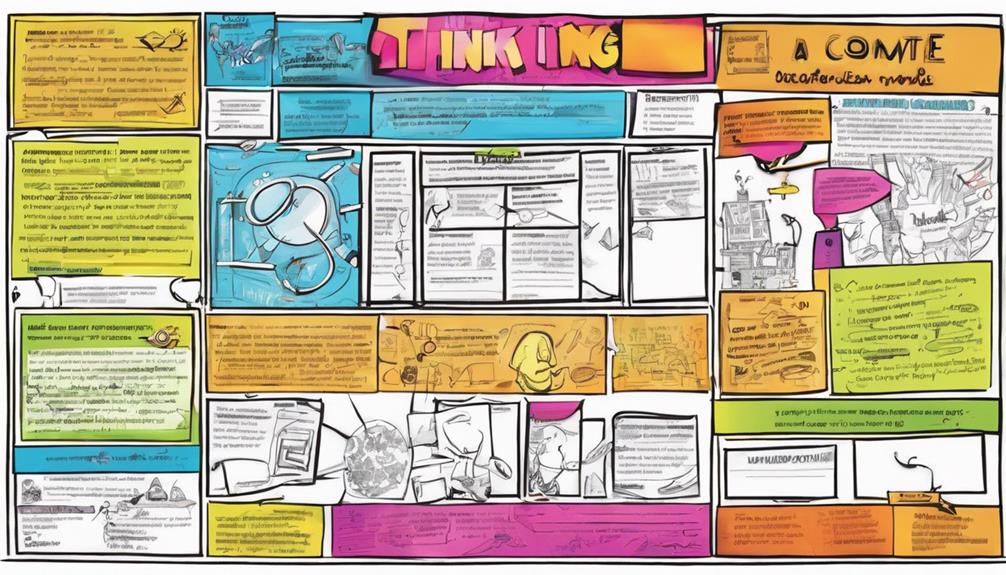Discover the ultimate design thinking worksheet for beginners. Immerse yourself in user-centered innovation and problem-solving with structured steps and practical tools. Harness the power of empathy, problem definition, ideation, prototyping, and testing. Create innovative solutions that align with user needs. Enhanced collaboration, creativity, and decision-making await you. Master essential principles like rapid prototyping, diverse perspectives, and the iterative process. Learn how design thinking transforms challenges into opportunities. Unleash your potential in innovation and problem-solving through this all-encompassing worksheet.
Key Takeaways
- Introduction to Design Thinking principles and process steps.
- Explanation of key tools and techniques used in Design Thinking.
- Step-by-step guidance on applying Design Thinking to solve problems.
- Interactive exercises and templates for hands-on practice.
- Tips for beginners on fostering creativity and collaboration in Design Thinking.
Benefits of Design Thinking
Design thinking boosts user satisfaction and loyalty by prioritizing understanding user needs and crafting user-centered solutions. By employing the Design Thinking process, teams are equipped to solve complex problems effectively. This approach encourages a structured method of problem-solving that involves empathizing with users, defining the core issue, ideating innovative solutions, prototyping ideas, and testing them for feedback.
Through this iterative process, teams can address intricate challenges with a focus on user experience and satisfaction.
Design thinking not only enhances problem-solving capabilities but also promotes a culture of collaboration and creativity within teams. By valuing diverse perspectives and ideas, this methodology fosters an environment where team members feel empowered to contribute their unique insights to projects. This collaborative atmosphere not only leads to more creative solutions but also improves decision-making processes by leveraging a range of viewpoints.
Ultimately, by embracing design thinking principles, teams can streamline project workflows, improve efficiency, and deliver more impactful outcomes for users.
Key Principles of Design Thinking

In the field of problem-solving methodologies, the core principles of design thinking revolve around user-centric innovation and rapid prototyping. Design thinking emphasizes understanding and meeting user needs effectively, putting the user at the center of the design process. This approach promotes a bias towards action, encouraging teams to quickly prototype and test ideas to gather feedback and iterate.
Another key principle of design thinking is the value it places on diverse perspectives and ideas. By fostering a culture of collaboration and experimentation, design thinking enables teams to approach problems from different angles and generate innovative solutions.
Prototyping and testing are seen as pivotal steps in the creative problem-solving process, allowing for the exploration of multiple potential solutions.
Through the use of empathy and creative problem-solving techniques, design thinking helps teams tackle complex problems by thinking outside the box and developing solutions that truly address the underlying needs of users.
Design Thinking Process Steps

Start on the journey of problem-solving by understanding the five key steps of the Design Thinking process.
The process begins with Empathize, where you explore understanding the user's needs and challenges.
Next, Define involves synthesizing your research to determine the core problem that needs to be addressed.
Ideate is where creativity flourishes as you brainstorm and generate innovative solutions without constraints.
Moving on to Prototype, you bring your ideas to life in a tangible form to test and refine.
Finally, Test is where you gather feedback from users to evaluate the effectiveness of your solutions.
Each step plays a vital role in guiding you through a human-centered approach to problem-solving, emphasizing empathy, collaboration, and iteration.
By following these steps, you'll develop a new perspective on how to tackle challenges, focusing on user needs and fostering creativity.
This structured process empowers beginners to embrace a design thinking mindset and create impactful solutions.
Tools and Techniques

To equip yourself with effective problem-solving strategies, explore various tools and techniques such as personas, journey mapping, brainstorming, rapid prototyping, and user testing.
Personas involve creating detailed user profiles to understand their needs and preferences better.
Journey mapping helps visualize the user experience from start to finish, enabling you to identify pain points and opportunities for improvement.
Brainstorming allows for the collaborative generation of a wide range of ideas to creatively tackle a problem.
Rapid prototyping involves building quick, low-cost models to test and iterate on potential solutions swiftly.
Finally, user testing is essential for gathering feedback from real users to refine and enhance prototypes effectively.
Design Thinking Resources

Explore a variety of resources that examine into the principles and tools of Design Thinking to enhance your problem-solving and innovation skills.
Design Thinking is a human-centered approach to innovation that emphasizes understanding user needs and promoting collaboration and iteration. Key principles such as user-centric solutions, bias towards action, prototyping, valuing diverse perspectives, and fostering experimentation guide this process.
The five stages of Design Thinking—Empathize, Define, Ideate, Prototype, and Test—utilize tools like personas, journey mapping, brainstorming, rapid prototyping, and user testing to drive innovation.
About the Author

With a background in content marketing and experience as a design thinking facilitator, Carrin Robertson brings a wealth of knowledge to guide beginners effectively through the design thinking process. Carrin, a Content Marketer at SessionLab and a seasoned problem solver, has honed her skills by working closely with community projects, helping them harness the power of design thinking.
As a facilitator, Carrin has led teams through the intricacies of the design thinking process, consistently delivering successful outcomes. Her expertise lies in making the introduction to design thinking both enjoyable and easily understandable for novices. Carrin's dedication to spreading the principles of design thinking is evident in her creation of the Design Thinking For Beginners Workbook & Presentation, designed to provide participants with a detailed guide to navigate the process seamlessly.
- Carrin's passion for empowering beginners shines through in her approach to teaching design thinking.
- Her commitment to community projects demonstrates her belief in the transformative power of design thinking.
- Carrin's experience as a facilitator showcases her ability to guide teams towards innovative solutions.
- Her expertise in content marketing adds a unique perspective to her design thinking facilitation.
- Carrin's dedication to creating accessible resources highlights her desire to make design thinking accessible to all.
Frequently Asked Questions
What Are the Five-Five Steps of Design Thinking?
You start with Empathize to understand users, then Define the problem, Ideate for creative solutions, Prototype your ideas, and Test them. Each step builds on the last, guiding you through the design process.
What Are the 4 Questions of Design Thinking?
To understand the 4 questions of design thinking, focus on understanding users, defining problems, ideating solutions, and testing and iterating. These questions guide the process, ensuring user-centered, innovative solutions are developed effectively.
Where to Start With Design Thinking?
Start by understanding user needs and creative problem-solving. Familiarize yourself with the five stages: Empathize, Define, Ideate, Prototype, Test. Practice using tools like personas, journey mapping, brainstorming, rapid prototyping, and user testing.
What Are the 5 Points of Design Thinking?
Start by understanding user needs, defining the problem, generating ideas, building prototypes, and testing solutions. Design Thinking's 5 points – Empathize, Define, Ideate, Prototype, and Test – guide you through a creative, user-centric problem-solving approach.
Conclusion
So, as you immerse yourself in the world of design thinking, remember: Rome wasn't built in a day, and neither is a great design.
But with the right mindset and tools at your disposal, you'll be well on your way to creating innovative solutions and transforming your thinking process.
Keep practicing, keep iterating, and soon enough you'll be a design thinking pro!









